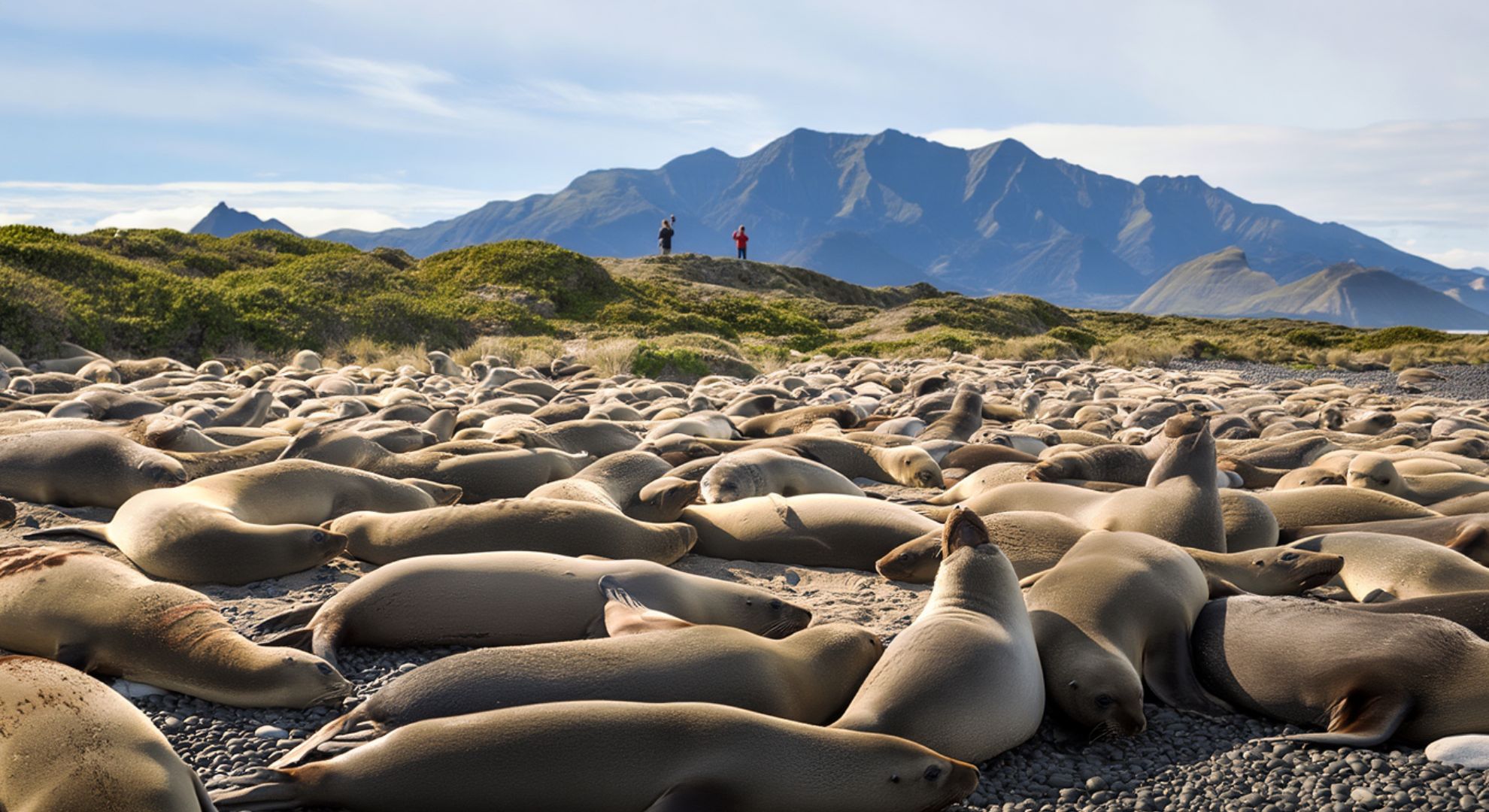Salt spray hung in the air as the morning tide receded, and a new rhythm took hold of the shoreline. What was once a quiet strip of sand now thrummed with flippers, whiskers, and curiosity. Residents paused, visitors stared, and the surf carried a chorus of barks across the bay. In the sudden hush between waves, the scene felt both unexpected and entirely natural.
A sudden takeover of the tide line
Over recent days, a bustling community of seals has settled on a crescent of sand near Kaikōura. The animals sprawled across sun-warmed rocks, shuffled around driftwood, and snoozed in tight clusters. Onlookers described the sight as “chaotic, adorable, and slightly surreal.” The shoreline, usually dotted with towels and boards, now belongs to sleek, blinking veterans of the sea.
Wildlife staff say the shift follows a classic haul-out, a seasonal behavior where seals gather in numbers to rest. Calm seas, abundant food, and shelter from prevailing winds drew the animals in like a magnet. In the hush of mid-morning, the colony stretched, yawned, and returned to a rhythm of sleep and sea.
Why this shore, and why now?
Kaikōura sits at a crossroads of deepwater currents and rich upwellings that funnel prey toward the coast. Kelp beds sway offshore, hosting fish and squid that keep hungry mouths fed. After the 2016 earthquake, subtle coastal uplifts reshaped ledges and inlets, creating new nooks perfect for lounging. When the weather lines up, this shoreline becomes a retreat—a natural rest-stop on an ancient route.
Season also plays its part in the seals’ daily calendar. Outside breeding peaks, adults and juveniles disperse to rest and recover condition. Haul-outs can swell quickly, then thin as animals forage again. What looks like a permanent takeover is often a phase, shaped by winds, prey, and tide.
Voices from the waterfront
“I walked down for a swim and got the surprise of a lifetime,” said a local resident. “They were everywhere—grumpy, sleepy, and completely unbothered by us.”
A surfer rolled his board under one arm, grinning and resigned. “The left is firing, but the lineup’s full of whiskers,” he joked. “I’ll give it a few days and respect the locals.”
A conservation ranger, watching from a careful distance, noted: “This is a healthy sign of a thriving ecosystem. The best thing we can do is stay back and let them rest.”
The etiquette of sharing the sand
Living alongside wild animals is a delicate dance. The rules are simple, kind, and remarkably effective.
- Keep at least 20 meters away, leash dogs, never feed or touch, stay quiet, and never place yourself between a seal and the sea.
A little space protects people, dogs, and seals from hazardous surprises. It also allows the animals to conserve energy, especially juveniles and mothers with pups nearby—even when pups are out of sight.
What the experts look for
Rangers watch for normal haul-out behavior: dozing, grooming, playful nips, and the occasional squabble. A seal that sits upright with head high may be alert or stressed; repeated coughing, bleeding, or labored breathing warrant a call to authorities. Most of the time, the best intervention is none, beyond giving them room.
New Zealand fur seals, locally called kekeno, have rebounded from historical hunting. Their return is a rare good-news story in an era of marine declines. Every haul-out is a living reminder that conservation can work when protected areas and community patience align.
Then and now: a quick comparison
Here’s how the shoreline feels to people and wildlife before a haul-out and during the current gathering.
| Aspect | Before haul-out | During haul-out | Notes |
|---|---|---|---|
| Beach use | Swimmers, surfers, families | Restricted zones, slower foot traffic | Safety first protects animals and people |
| Soundscape | Wind, waves, seabirds | Barks, snorts, splashes | A living soundtrack of wild neighbors |
| Sightings | Occasional individuals | Dense clusters, pups and juveniles | Numbers fluctuate with weather and food |
| Tourism | Scenic stopovers | Wildlife-centered visits | Local businesses pivot to seal-safe viewing |
A ripple through town and tide
For the hospitality crowd, curiosity has become a gentle boom. Cafés serve flat whites to visitors who just want to watch the shoreline breathe. Tour operators adjust schedules to avoid sensitive areas, leaning into ethical viewing that keeps the animals undisturbed. The town’s rhythm shifts, but few seem unhappy about it.
“Nature’s putting on a show, and we’re lucky to have front-row seats,” said one shop owner. “It feels like the ocean is reintroducing itself, on its own terms.”
Reading the signs of a healthy coast
A crowded haul-out means prey is plentiful, habitats are intact, and disturbances are low. It also signals that marine mammals still find refuge along a busy coastline. Challenges remain—fishing gear, plastic, boat strikes—but moments like these offer a glimpse of balance. The beach wears a temporary coat of wildness, and the community learns to live around its new tenants.
What happens next
The colony will likely thin as conditions change, tides swing, and the animals follow their roaming maps. Some will move to nearby rocks; others will vanish beyond the blue horizon. The lesson, locals say, is to let the coastline set the tempo. When the sea sends guests ashore, the kindest response is to offer space and time.
As evening falls, the wind shifts and the chorus settles, replaced by the soft rush of waves. The sand is stitched with flipper tracks, a temporary script the tide will soon erase. Tomorrow, the story may change, but tonight, the beach belongs—firmly and beautifully—to the wild.
